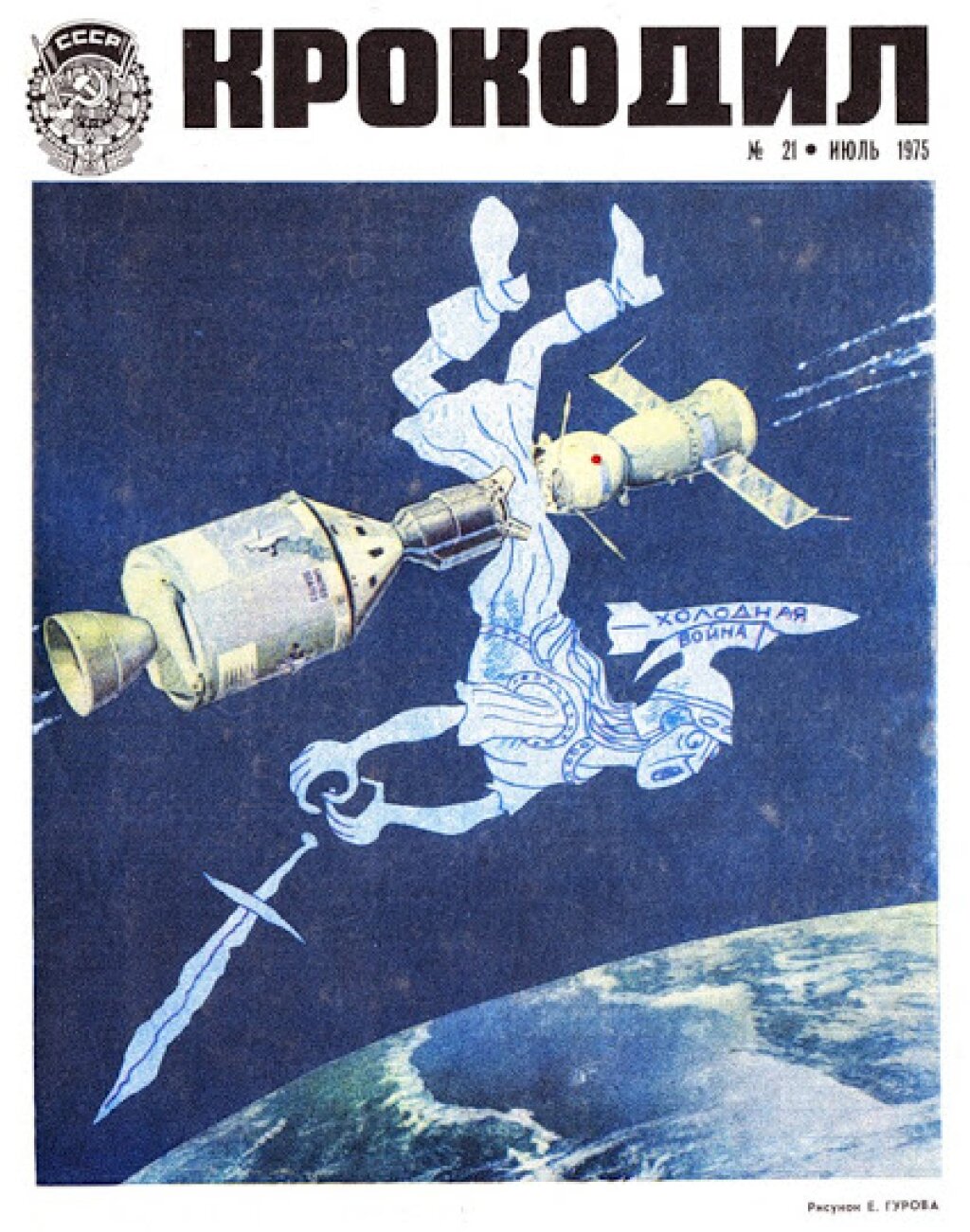This is Part I in a two-part series. Part II will follow on Wednesday, 3/10.
Dr. Andrew Jenks is a Professor of History at California State University, Long Beach, and author of books on Yuri Gagarin, Palekh lacquer boxes, environmental disasters, and the forthcoming from Anthem Press: When the Space Race Ended: Collaboration in Space and the Search for Peace on Earth.
Known as the “handshake in space,” the July 1975 Apollo-Soyuz rendezvous in low Earth orbit was an anchor of the policy of détente between the United States and the Soviet Union, as well as a technological fix designed to make superpower relations less dangerous and more secure. It had the added benefit of advancing the cause of space exploration, thus killing two birds with one stone or, in the spirit of joining two different ways of looking at a similar problem, "killing two rabbits at once" (as the Russians say). The technical problem of collaboration had been hashed out in 1970 among Soviet and American engineers, who occupied ground zero in the techno-politics of détente.
Negotiations focused first on a linkup between the Soviets and the nascent Skylab project at NASA (which would be launched in 1973 and 1974). But due to the existing designs of docking systems for both sides, the Soviets quickly rejected this idea as requiring joint construction of not just the docking mechanisms, but of all other aspects of launch and capsule systems that would permit the docking.
Existing docking systems, as Soviet and American engineers had conceived them, involved one spaceship (the "male") "penetrating" the other (the "female"). Neither side had the will, time, or money to figure out who was going to perform which role, much less how to redesign existing systems to accommodate the penetrating/penetration (needless to say, all parties involved were men). As is often the case with technological fixes, the fix itself creates a whole new set of problems that make the “fix” seem like a new problem in need of additional fixing. Such a redesign, from the Soviet point of view, would have meant supplying sensitive information about the design of their systems, an act of trust they were not confident the Americans would reciprocate. The Soviet task seemed primarily to provide support services for the star attraction, that is, the new technology of the American Skylab. Moreover, Brezhnev and Nixon both wanted a quick fix as well as a technological one, and linking up with Skylab was neither quick nor technologically simple.
The only solution was to find a universal docking mechanism that would connect peripherally to the two existing systems (Apollo and Soyuz), thus allowing both sides to meet each other in space on their own terms and in their own space systems. It would take more than two years after 1970 to work out this mechanism's design.
Even before the Apollo-Soyuz Test Project (ASTP), both sides were separately working on a docking system engineers dubbed the “APAS” (Androginno-periferiinyi agregat stykovki, or "androgynous peripheral assembly system"). Its roots go back to the mid-1960s, when Soviet engineers sought to develop a new docking mechanism between different Soviet capsules. Before ASTP, the Soviets were using a “mama and papa” docking system (the colloquial reference among Soviet engineers for “shtyr’-konus [rod-cone]") that was obviously gendered and involved the combination of "passive" with "active" elements. The Americans had used a similar design, which NASA engineers (also mostly male) referred to as “male-female.”
These types of docking systems required the penetration of one capsule by the other, which, given the male-dominated and macho engineering cultures on both sides, turned the "female" side into an optically undesirable political hot potato.
[gallery ids="6575,6556"]
The design idea for the "mama-papa" system, according to Soviet docking engineer Vladimir Syromiatnikov, had come from
the age-old principle of mating on Earth, mastered by Mother Nature…two free-flying spacecraft, similar to buses in size and mass, would get coupled and then structurally engaged, and then flew in this mode until separation.
Like their counterparts among American defense intellectuals, Soviet engineers often imagined their work in sexual terms. Mating thus became a convenient shorthand for complex engineering couplings. Through the mid-1960s, docking simulations were popular events among space managers, engineers, and politicians in the secret Soviet space testing facility, a kind of mechanical peep show. “Docking became a popular performance, something like a space-themed erotic show,” Syromiatnikov remembers. “Hold the stallion,” said one engineer, positioning the probe at the entrance of the cone.
Their "erotic" potential notwithstanding, the limitations of "mama-papa" docking systems soon became a source of frustration, including to Chief Engineer Sergei Korolyov. By the early 1960s, the Soviets were moving from merely launching capsules into space to actually joining them together, like lego pieces, for projects involving longer-term habitation and space colonization. Korolyov pushed Syromiatnikov to design a new kind of docking system, fundamentally different from its predecessor, that would create a pressurized tunnel between the two docked spaceships and not require the re-engineering of both ships to accommodate the “mama-papa” penetration. Syromiatnikov continued to work on such a system even after the deaths of Korolyov in 1966 and Yuri Gagarin in 1968.
The solution was an "androgynous" docking system. In this scenario, two distinct systems could be docked without one having to be penetrated by the other. APAS would have grabbing mechanisms attached to both objects to be docked, with a passageway created between them when they interlocked. The engineering and design of either object would not depend on the engineering and design of the object to which it would attach.
Depending on the situation, one side could be the "active" partner (initiating the grabbing) and the other the "passive" one (waiting for the embrace), but the roles could also be reversed. The result was a kind of space hug. This design innovation was both a clever solution to avoiding re-engineering the capsules of both sides so that they could dock, and an attempt to disarm the idea of sexual domination in the Cold War implied by previous “mama-papa” docking designs. By mid-1971, the ASTP docking mechanism was officially dubbed “androgynous,” in a node to the androgyne of Greek mythology. The technological fix for Superpower relations was in.



